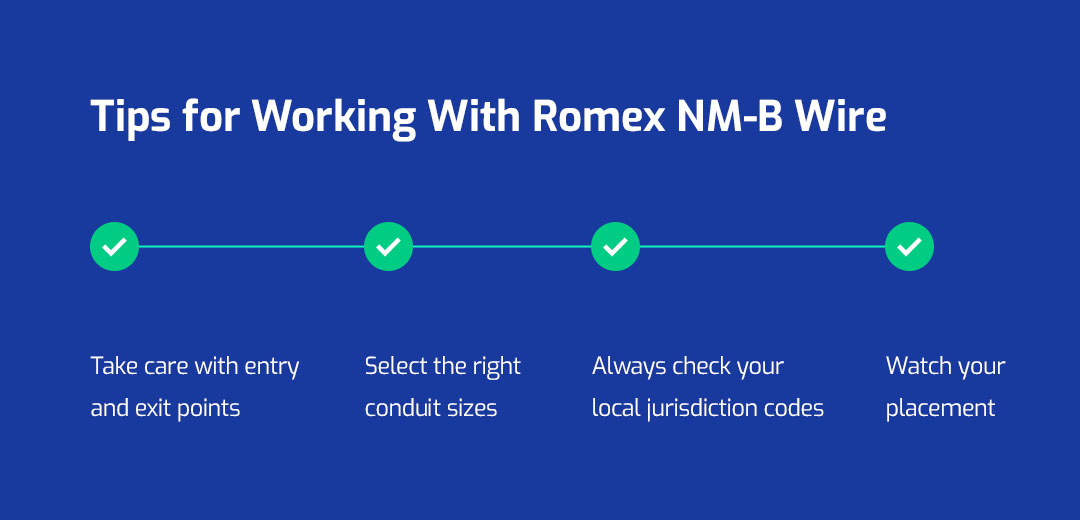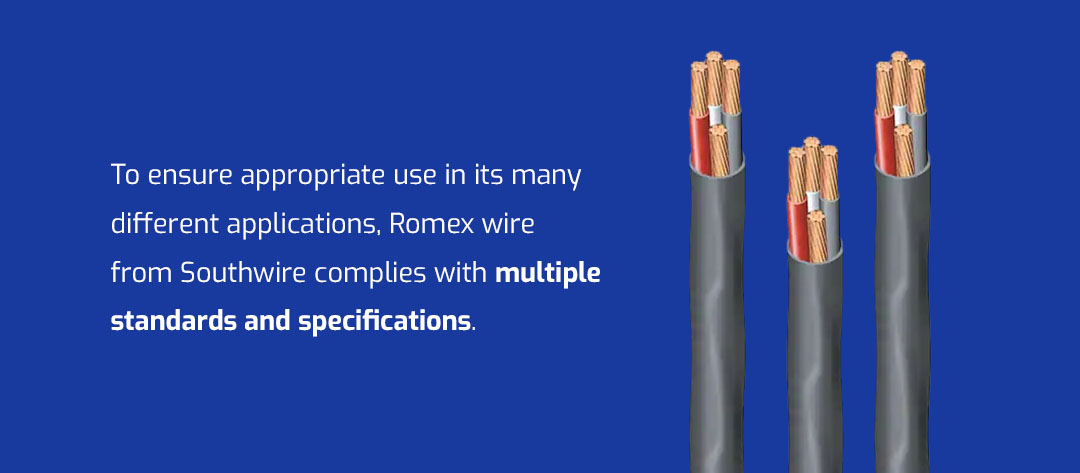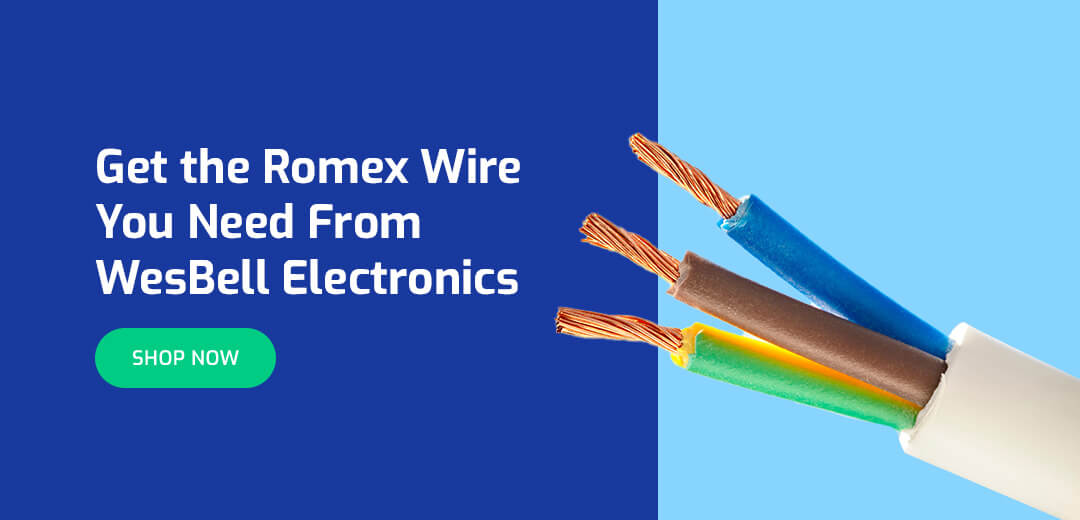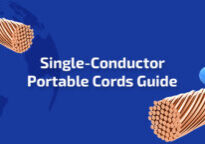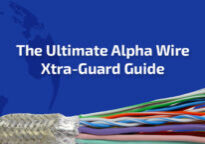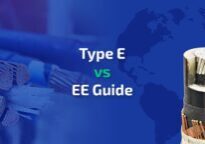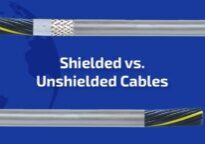
May 5, 2023
Romex Wire Guide
Romex® is a well-known brand name created by Southwire, a trusted provider of wires and cables in the United States. Romex wire is a type of nonmetallic (NM) sheathed electrical cable widely used for various dry indoor wiring applications. While other companies also make NM wire, Romex is the most recognized brand name in the industry. It’s so popular that electrical professionals often refer to all NM wires as Romex, even for cables from other brands.
In this guide, you’ll learn everything you need to know about Romex NM-B wires and how to work with them.
What Is Romex NM-B Wire?
Romex NM-B wire is a branded version of nonmetallic sheathed electrical cables. The “NM” in the acronym stands for “nonmetallic,” and the “B” refers to the wire’s use as a branch circuit wire. You may also see “SIMpull®” alongside Romex, as this is the name for their trademarked PVC jacket design.
Romex wire contains thermoplastic high heat-resistant nylon-coated (THHN) wires — made with annealed soft copper — contained in a PVC jacket. There is also an additional bare copper ground wire. This versatile electrical wire is suitable for outlets, switches, lighting, appliances, HVAC systems, electrical circuits and electrical wiring within walls, ceilings and floors.
However, Romex cables are unsuitable for outdoor use due to their sensitivity to moisture and UV rays. Water, oil, gas and other liquids may penetrate the jacket and damage the connection. This means you cannot bury Romex cables in the ground or embed them in concrete.
Types of Romex Wire
Romex wire comes in several sizes, ranging from American Wire Gauge (AWG) 14 to 2. It’s also available with two or three conductors. Southwire color-codes their Romex wire to make it easier to tell the difference between sizes. Romex wire sizes and their corresponding jacket colors include:
- 14 AWG: White jacket
- 12 AWG: Yellow jacket
- 10 AWG: Orange jacket
- Greater than 10 AWG: Black jacket
Romex® wire comes in several convenient sizes ranging from American Wire Gauge (AWG) 14 to 8. They’re also available with two or three conductors. We understand that you have exact lengths and want to limit waste, so we allow you to purchase any length at all on Romex® wire. Plus, we offer discounts on bulk purchases.
Romex® wire comes in different sizes depending on how much power needs to be run. The most popular sizes are the 14 AWG, 12 AWG and 10 AWG, and they are each specified with their own color. The Romex® 14/2 and 14/3 have a white jacket, the Romex® 12/2 and 12/3 have a yellow jacket and the Romex® 10/2 and 10/3 come in the orange jacket. Anything bigger than the 10 AWG Romex® comes in a gray outer jacket. You must request a minimum run of 50,000 feet of wire to get different colors in these large cables.
The color codes make it much easier for an electrical contractor to tell the difference between cables just by looking at them. For instance, they might get a phone call from a residential customer who needs to replace a cut or ripped wire. They can ask what color the wire is and ensure they bring the correct one for the job. The color only represents the AWG size of the wires inside the jacket, so an electrician can tell what size it is by looking at it. You should always speak to an electrician before trying to pick an AWG size yourself because there are many different factors to consider first. They will ask you the proper questions to get the necessary information and then calculate the right AWG size.
Romex Approvals
To ensure appropriate use in its many different applications, Romex wire from Southwire complies with multiple standards and specifications. These include those from industry regulatory organizations such as Underwriter Laboratories (UL), ASTM International and the National Fire Protection Agency (NFPA). The specific standards and regulations Romex complies with are:
- UL Standard 719
- UL Standard 83
- ASTM B-3 and B-8
- Federal Specification A-A-59544
- National Electrical Code or NFPA 70
Romex is also Registration, Evaluation, Authorization and Restriction of Chemicals (REACH) and Restriction of Hazardous Substances (RoHS) compliant. All Romex® wire is manufactured in the U.S. with a cost-efficient process that makes it great for basic indoor applications. This intended use means it must be built to certain standards. As long as the wire is made domestically, then you can be assured you’re getting the right product, especially since all Romex® wire comes from Southwire.
At WesBell, we buy all of our wire and cable from the largest, most reliable manufacturers in the industry, like Southwire, who require large stocking orders and year-end minimums. Not only does that mean we sell a quality product from the source, but we also have the cheapest price. The Southwire brand means you’re getting a product that came from the best in the business.
Romex vs. Other Cables
All Romex and NM-B cables must stay indoors as they have insufficient protection to withstand outdoor conditions. If you need a similar electrical cable for outdoor use, consider one of the following options:
- Underground feeder cables: Underground feeder and branch-circuit (UF-B) cables are more suitable for outdoor and underground applications. They have the same inner wires as Romex, but the ground wire and THHN wires inside have extra protection from the durable UF-B jacket. You can bury UF-B cables underground to hook up a new electrical panel in places like barns or garages.
- THHN wires: If a single-conductor electrical wire works for your application, use a THHN wire. These are the conductors within Romex cables. You can also choose thermoplastic heat- and water-resistant nylon-coated (THWN) wires, which can handle higher temperatures in wet conditions.
- Type MC cables: Another outdoor option is Type MC cable, which contains THHN wires and an additional green THHN wire as a ground. The “MC” in the name stands for “metal-clad” because these wires have an aluminum metal-clad jacket. This durable jacket protects the cable in wet conditions and is great for pushing it through conduit.
How to Cut and Strip Romex Wire
To install Romex wire, you must cut it and remove some of the exterior sheathing off the end. This process is called stripping. You can use a cable ripper or utility knife to remove the sheath. Follow the wire’s contours carefully to avoid nicking or cutting them.
When stripping cable with a utility knife, always work on a flat vertical or horizontal service. Cut away from your body instead of toward it. Remember that the larger the cable, the more pressure you must apply. Be careful when cutting the jacket off to prevent injuries, or hire a professional to do the job for you.
Tips for Working With Romex NM-B Wire
While Romex cables work well for many indoor applications, you’ll still have to take some precautions when installing them. Here are a few of our tips for working with Romex NM-B wiring:
- Take care with entry and exit points: Your priority must be preventing damage to the cables at any point where they enter or leave an enclosure. Use connectors or bushings specifically manufactured for Romex to protect the cable at these points.
- Select the right conduit sizes: When choosing a conduit for Romex wires, choose the correct size to prevent damage. A conduit that is too small can bind or crush the cable’s sheathing. The cable should pass through the right size conduit easily when you have the right size.
- Always check your local jurisdiction codes: Regulations for electrical wiring can vary from state to state. If you plan on installing Romex wires, contact your local code enforcement building department for guidance. They will send a building inspector and an experienced technician to check and approve your wiring project.
- Watch your placement: Place Romex wires in a conduit to protect them in areas with sharp edges that could cut the cable. Secure Romex cables to the wall, ceiling, or floor with staples or straps at regular intervals to prevent sagging or bending and keep them safe.
If you can, hire a good technician to help you obtain stable electrical conditions, especially when the wires are installed outdoors. Make sure you replace your Romex® wires after a year or two, and always have them inspected so they will still conform to NEC standards during use.
Romex® vs. Other Cables
Underground feeder (UF-B) cables are similar to Romex® wiring, but they offer more protection for outdoor and underground applications. This cable is only available in gray and does not need to be run through conduit, though you can choose to do so if you prefer. UF-B cable has the same inner wires as Romex® — it’s also made with THHN wires and a bare copper ground wire. However, with UF-B, the ground wire and the THHN wires are individually covered by the extra protection of the UF-B jacket.
All Romex®, or NM-B cables, must stay indoors. They cannot run outdoors at all because they don’t have enough protection to withstand outdoor conditions. You can pay slightly more for a UF-B cable that runs indoors, outdoors and directly underground without conduit. Each conductor is covered individually by the thick durable PVC jacket. UF-B is also known as an underground cable because it can be buried directly in the earth to hook up a new electrical panel in places like barns or garages.
If you don’t need multiple wires in one cable, you can opt for the thermoplastic high-heat nylon wire (THHN) or the thermoplastic high-heat water-resistant nylon (THWN) wires on their own. These are the wires that make up the conductors within Romex®. We also have hook-up wire for indoor use on appliances and welding cable for flexible outdoor use.
Moving from Romex®, the next step up for an outdoor cable is Type MC cable, which is also made with THHN wires and an additional green THHN wire as a ground. Having a THHN ground wire means the cable can be used outdoors or in conduit because there’s no chance of moisture hitting the bare copper. “MC” stands for metal-clad because the jacket is an aluminum metal-clad jacket, which is great for pushing MC cable through conduit.
We also offer many types of portable power cable that have rubber insulation and jacket for added flexibility and protection outdoors.
Get the Romex Wire You Need From WesBell Electronics
At WesBell, we sell only high-quality Romex wire from Southwire to provide you with long-lasting, cost-effective cable for many indoor applications. We offer quality products from the source and have the lowest price for Romex wire. We also stock a range of other wire types to help you complete any wiring project. If you’re unsure what you need, our expert technicians can help you find the right wire for your project.
In addition to top-of-the-line customer service, we offer wire processing services. Our team can cut, strip and otherwise prepare cables for your application, so you don’t have to do this task yourself.
Browse our selection of Romex wire online. If you need help finding a solution, get in touch with us today!

